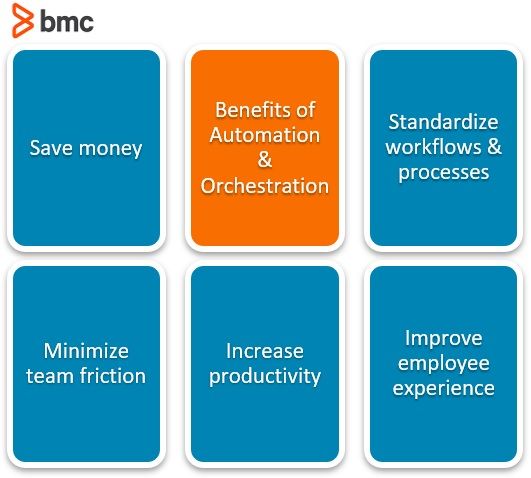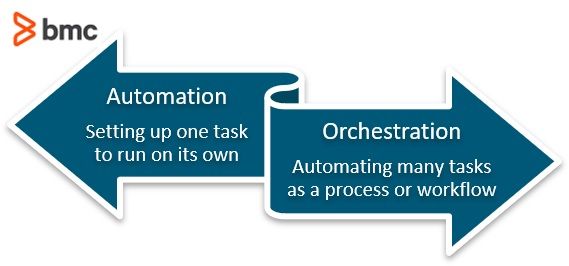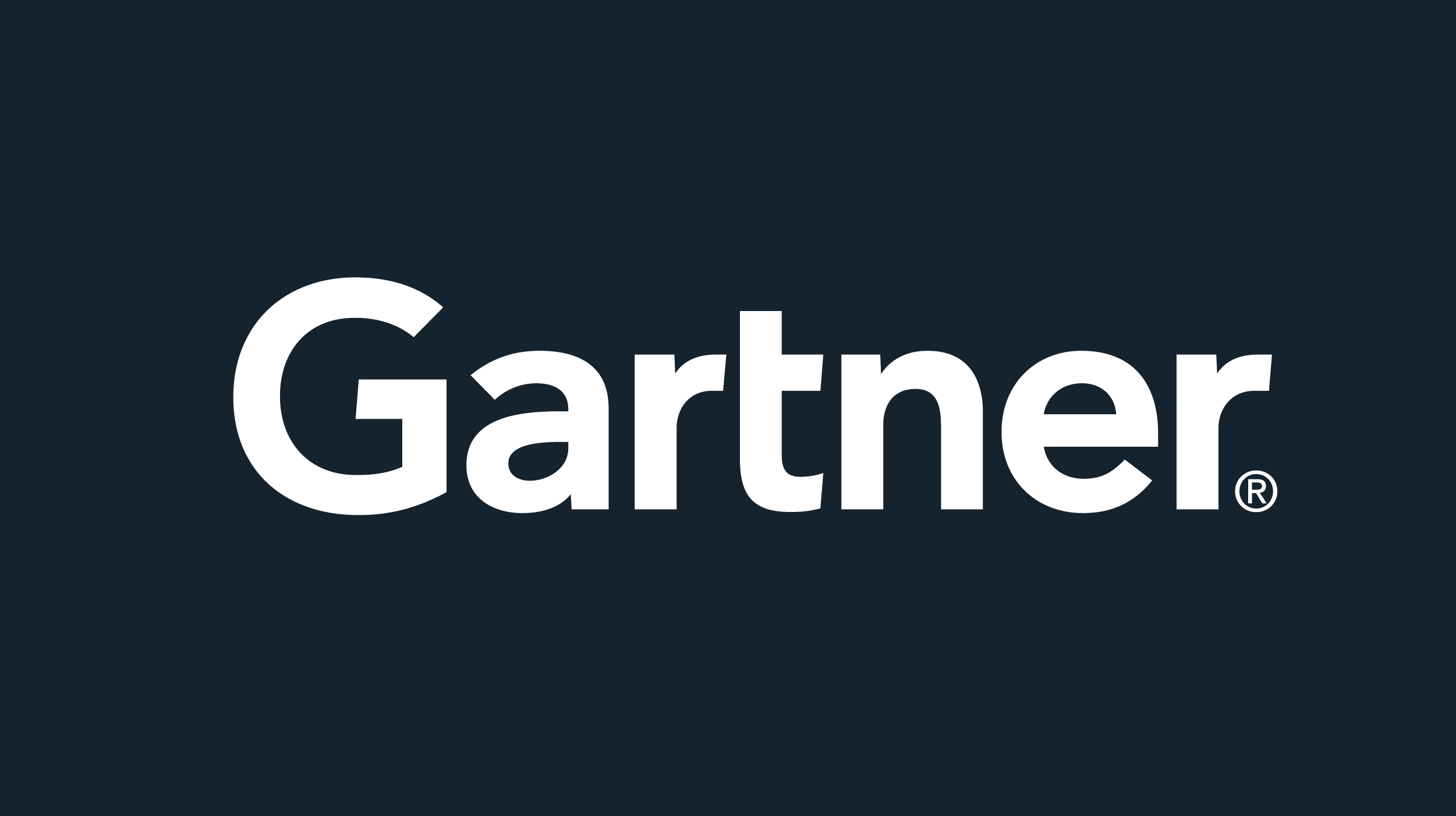Automation is a big topic for companies, no matter the industry. Whether your job is in IT or another business area, you’re likely hearing about automating as a way of saving money, improving efficiencies, and removing inherent errors.
Often, automation is a term that may be used only partially correctly. The term orchestration, by contrast, is used less outside technical areas, but it’s more often what we mean when we talk about automation. Whichever term, automation and orchestration are both essential to successful digital transformation.
In this article, we’re exploring the different but related concepts of automation and orchestration by:
- Defining automation and orchestration in IT
- Clearing up the differences
- Sharing how beneficial both are, when used in tandem, in a DevOps culture
What is automation?
When we hear about automation, it’s typically in reference to making entire processes or workflows run. This isn’t quite right.
The definition of automation is setting up a single task to run on its own—automating one task. Automating a task can apply to both desktop-only tasks and cloud tasks. This single task can be anything:
- Launching a web server
- Stopping a service
- Integrating a web app
- Channeling an email to a predetermined folder
Individuals can automate daily tasks to improve their efficiency, but companies of all industries and sizes look to automation to increase efficiency at scale.
What is orchestration?
Frequently, orchestration is what we actually mean when we are talking about automating. Orchestration is automating many tasks together. It’s automation not of a single task but an entire IT-driven process. Orchestrating a process, then, is automating a series of individual tasks to work together.
If orchestration sounds more fancier than automation, that’s because it is—at least it is more complex. In enterprise IT, orchestrating a process requires:
- Knowing and understanding the many steps involved.
- Tracking each step across a variety of environments: applications, mobile devices, and databases, for instance.
More formally, the definition of orchestration includes the automated arrangement, coordination, and management of:
- Computer systems
- Middleware
- Services
Use cases for orchestration
Orchestration takes advantage of multiple tasks that are automated in order to automatically execute a larger workflow or process. These could be comprised of multiple tasks that are automated and could involve multiple systems.
The goal of orchestration is to streamline and optimize frequent, repeatable processes. Companies know that the shorter the time-to-market, the more likely they’ll achieve success. Anytime a process is repeatable, and its tasks can be automated, orchestration can be used to optimize the process in order to eliminate redundancies.
For tech-enabled companies (which is practically everyone), the main use cases for orchestration include:
- Speedier software development
- Batch processing daily transactions
- Managing many servers and applications
- Data analytics
Here’s an example: A developer needs to enter a line of code throughout the software. At first glance, it the developer may think it’s a quick line of code that’s easy to manually insert. But entering code manually, by hand, introduces the risk of human error. This risk must be minimized in live environments in particular. Even if this risk is introduced in testing, the developer still spends valuable time fixing an unnecessary error.
Instead, the developer can opt to orchestrate this additional code by automating the individual tasks that comprise the process of inserting this code. That’s nice on its own—it might not even seem necessary. Importantly, however, the developer ensures that bad code isn’t entered, increasing efficiency.
Automation and orchestration benefits
Automating one task may impress your users or make them aware that something has sped up a little bit. On its own, simple automations will not make a big perceivable difference. But when automation is built into a series of processes and workflows, which are then orchestrated to run automatically, there can be endless benefits.

Common benefits include:
- Saving money. You might decrease overall IT costs or decide to use the budget towards innovation and new projects.
- Minimizing team interactions. Team collaboration is certainly valuable, but it can also introduce friction into projects and processes. Orchestrating certain workflows and processes can minimize this friction among teams.
- Increasing productivity. Instead of using human power on rote tasks, you can work on projects that require human thought, decision making, and skills.
- Standardizing workflows and products. Standardizing processes and products across the spectrum means your processes and products are consistent and reliable—and your company will come to be seen this way, too.
- Improving employee experience. Employees who spend their time on more creative, thoughtful, or challenging tasks, not plug and play tasks that can be automated, are more likely to appreciate their work environment.
Automation and orchestration in DevOps
As DevOps ways of working are becoming the norm, holistic DevOps cultures are more common. And automation and orchestration are essential to DevOps culture.
Here, in DevOps world, you’re likely both orchestrating and automating DevOps. Using both means they can be played off each other to streamline and accurately execute processes that lead to speedier and successful app deployments. You’ll likely start with automating individual technical tasks. Then, as you continuously automate, you’ll start orchestrating entire IT workflows that are comprised of numerous technical tasks.
Well-orchestrated IT processes enable, support, and empower key DevOps theories of continuous integration (CI) and continuous delivery (CD). The more processes that are orchestrated, the more DevOps engineers can work with other teams to create apps that meet a lot more—perhaps one day all—requested requirements.
Get started orchestrating: Beginner tips
At this point, you may be wondering why you aren’t automating or orchestrating all your IT needs. Some people say this is the next step of DevOps—known as NoOps: when developers are freed from tasks altogether in order to continue innovation.
Automation and orchestration can occur on an individual level or on a team- or company-wide level. Both non-IT and IT employees can take advantage of automation suites that can integrate many popular apps, like email, Microsoft and Google products, Slack, sales and marketing tools, and a lot more – requiring no programming or coding know-how.
Automating larger or more custom suites, like an in-house software solution, will require IT build out the workflows. In this scenario, you’ll need to prioritize workflows and processes.
Here are a few tips on choosing how and what to automate and orchestrate:
- Consider the business need. You could automate a million tasks that might make things easier for individuals or only IT teams—but this misses the larger goal of creating business value. Consider how much time to spend on automating tasks that feel good but don’t help the business.
- Remember the goals of speed and accuracy. Automate tasks that applications or machines can do with more speed and accuracy than a human can. Even if it’s something small, like our example of inserting a line of code: this can avoid costly human errors.
- Orchestrate to free up employee time. Orchestrate workflows that free up the team. With less rote tasks, the team can tackle more valuable projects that are not easy to orchestrate, like creative and innovative output, or the start of a new project.
- Choose projects that create significant and measurable business value. If you’re using orchestration only to speed up how quickly tasks get completed, you’re not receiving the true business value that orchestration can provide.
As automation and orchestration continue to improve tasks and automation, more teams – both IT and otherwise – are able to work towards an ideal product that incorporates a larger amount, or eventually all, of the requested requirements.
How to choose automation/orchestration tools
Because orchestration is a complex task by nature, a variety of tools can help you achieve orchestration easily. When considering which tools are best, consider these factors:
- The task at hand. Do you need to orchestrate IT infrastructure workflows, or software development workflows? The tools for these jobs are different.
- Simplicity. Is it simple enough or too simple?
- Auditability. Does your tooling create and support an audit trail, which many industries require for compliance?
- Scaling in production. Can your tooling handle scaling up or down as peaks demand?
- Data and analytics. As data overtakes us, will your tooling keep up with processing? One Control-M user shared how his company acquired two more companies, but with the right tooling, they experienced no major outages, loss of data, or scheduled processing.
Popular orchestration software
It’s nearly impossible to put together a list of all the software that falls into this category. But here are some common tools that are popular for specific orchestration tasks—you’ll likely come across these as you begin your research.
Ansible: Continuous delivery
Ansible is an open source infrastructure automation tool that automates repetitive tasks for people working in IT, such as:
- Cloud provisioning
- Configuration management
- Application deployment
- Intra-service orchestration
This tool targets Continuous Delivery (CD), a DevOps principle within the software development lifecycle (SDLC).
Control-M: Application workflow orchestration
Control-M orchestrates the application and data sources that comprise a business service. It’s a more general job scheduler and manager for batch files. It comes after you would use Ansible, when you need to orchestrate with other applications and data sources, to deliver a business service or business application, such as:
- End of day close
- Credit approval
- Billing
- Predictive maintenance
Where Ansible supports CD in applications, Control-M drives the execution, visibility, and control in production.
(Hear from real users how Control-M helps manage workflows.)
Hear more about BMC Helix Control-M and how it is helping customers improve and derive more value from their agility, customer centricity, and actionable insights.
Jenkins: Continuous integration
Jenkins focuses on building software, particularly at scale. Jenkins supports continuous delivery and integration. It’s built on the Java Virtual Machine (JVM) with more than 1,500 plugins for automating most software delivery-related technology.
Kubernetes: Orchestration for containers
Kubernetes is container platform that orchestrates computing, networking, and storage infrastructure workloads. Kubernetes orchestrates apps that you develop and ship in containers, making software development easier and laser-focused on the goal of the app—not the underlying infrastructure and environment. The general rule of thumb for K8S: if your app fits in a container, Kubernetes will deploy it.
(Learn more in our multi-part Kubernetes Guide, with articles and tutorials.)
What are SOAPs?
With many tools for automation and orchestration, it might get a bit confusing. Tech analyst Gartner coined the term SOAPs, short for Service Orchestration & Automation Platforms.
It seems that Gartner expects SOAPs to function as the single orchestration point for managing and executing automation tasks across the enterprise. That’s why they’ve recommended that Infrastructure and Operations (I&O) leaders invest in SOAPs—to drive digital innovation and business agility.
Related reading
- BMC Workload Automation Blog
- Workflow Orchestration vs. Continuous Integration: What’s the Difference?
- What is Workload Automation? WLA Explained
- Workload Automation (WLA) vs Robotic Process Automation (RPA): What’s The Difference?
BMC named a Leader in 2024 Gartner® Magic Quadrant™ for Service Orchestration and Automation Platforms
These postings are my own and do not necessarily represent BMC's position, strategies, or opinion.
See an error or have a suggestion? Please let us know by emailing blogs@bmc.com.








